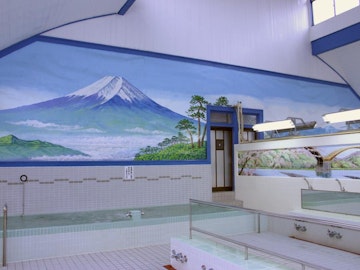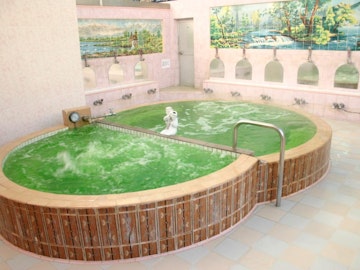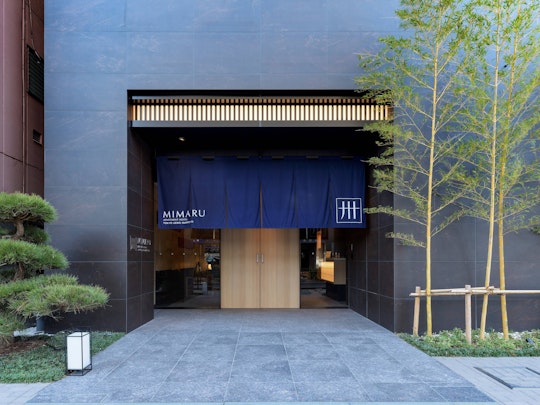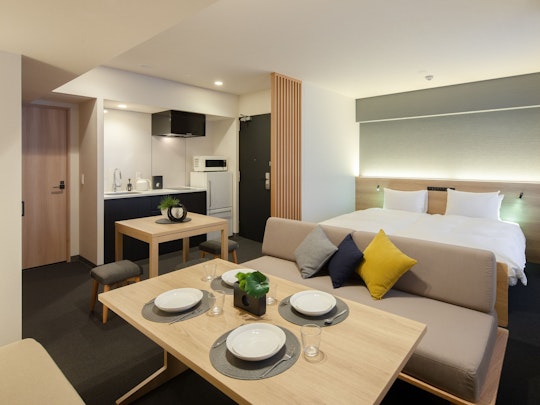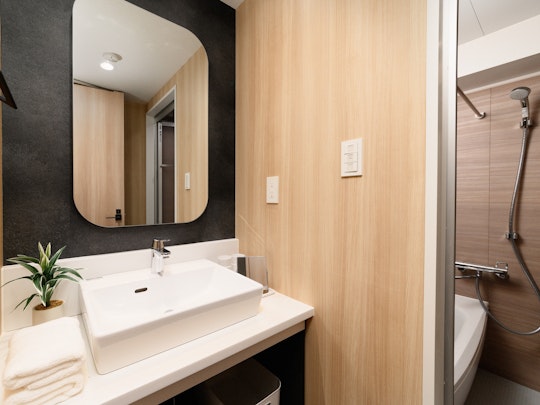Public bathhouses, called sento, have recently been receiving a lot of attention from guests visiting from abroad. Having gained popularity among the masses during the Edo Period, sento are a great way to get a taste of local Japanese culture passed down in each region. The Ueno and Asakusa areas in particular are dotted with sento that retain the charm of the Showa Era. With that in mind, MIMARU Tokyo Ueno Inaricho will begin selling tickets to Higashi-Ueno Kotobukiyu, a sento just a 2-minute walk from the hotel, from February 1, 2024. The staff will also provide information on the charms of sento and how to enjoy them, as well as the etiquette when using them, so that guests from abroad can easily try them for themselves.
We also conducted an interview with Ms. Yasuyo Yamaguchi regarding her advice to visitors from abroad about these points.
■ MIMARU Tokyo Ueno Inaricho sells tickets to the neighborhood’s popular open-air bath, Higashi-Ueno Kotobukiyu
MIMARU Tokyo Ueno Inaricho provides information on the neighboring sento, how to enjoy them, and sento etiquette. You can also buy tickets for Higashi-Ueno Kotobukiyu at the front desk.
・Map of sento in the area
・Sento rental sets (bag, information on using sento) ※Please use the towels in your room
・Sale of tickets to Higashi-Ueno Kotobukiyu
・An introduction to Higashi-Ueno Kotobukiyu on our official Instagram
https://www.instagram.com/reel/C1t4vEWMIBO/?utmsource=igweb_copy_link&igsh=MzRlODBiNWFlZA==
■ We Asked Yasuyo Yamaguchi, Sento Writer for the Tokyo Sento Association, about the Appeal of Sento, How to Enjoy Them, and Their Etiquette
Sento writers are volunteer journalists with a love for sento who have been officially recognized by the Tokyo Sento Association. They were selected through a public recruitment call in 2017 and have been reporting on Tokyo sento ever since. We asked one such individual, Yasuyo Yamaguchi, to introduce what she would like visitors to Japan to know about sento.
・Hot springs (onsen) are popular amongst visitors from abroad. What do you recommend about sento?
“Onsen are popular with guests from overseas, but we recommend visiting a local sento for those who are too limited on time to travel out to where they are located. If onsen are a special experience, then sento, which are a part of daily life for Japanese people, are tourist spots where you can enjoy the experience while simultaneously getting a deep sense of Japan’s unique culture. There are also sento in Tokyo that have onsen water, so we recommend them as well.
“The warmth of the water, the smell of the soap, the sound of the tubs, the shimmering of the water... I believe that sento are places where all five senses come alive to allow visitors to fully enjoy the comfort they provide. Feeling comfortable and relaxing are both universally appreciated experiences, so I think that people from anywhere in the world will be satisfied by a dip in the baths. Furthermore, since the goal of sento is to improve public hygiene, most of them allow those with tattoos to enter, so those who cannot enter onsen because of their tatoos can also enjoy the warm waters of a sento.”
・Questions from Visitors from Abroad Regarding Sento, How to Enter Sento, Sento Do’s and Don’ts
Q. Why are there often murals of Mt. Fuji in sento?
A. ”It is said that the pictures of Mt. Fuji started when the owner of Kikaiyu in Kanda Sarugaku-cho asked an artist he knew to paint something that children would enjoy. This artist was from Shizuoka Prefecture, and when he painted the view of Mt. Fuji from his hometown, it became so popular that it became the norm for sento in Tokyo to have a mural of Mt. Fuji. There are very few painters nowadays who can do sento mural paintings.”
Q. Why are after-bath drinks milk-based?
A. “Sento are associated with milk because of the times when Japanese families did not have refrigerators. They could not keep milk at home because it would spoil without refrigeration. Additionally, household baths were not yet widely available in 1955, so people largely visited sento daily. Dairy manufacturers teamed up with sento, aiming for the publicity effect that would result from making their products available where so many people passed through. They placed refrigerators with cold milk inside and, as people began to enjoy post-bath cold milk, being able to drink it by going to a sento became popular.”
Q. Why do sento have large baths?
A.” Although sento are associated with having plentiful water, it is believed that they started as steam baths when Edo (present-day Tokyo) was initially being constructed in the 17th century. Furthermore, mixed bathing was common during the Edo Period. The shogunate issued decree after decree banning mixed bathing, including the Kansei Reforms, yet the long-standing custom remained unchanged. It was not until the mid-Meiji Era that separate baths for men and women in sento were enforced after the government began to crack down on mixed bathing due to criticism from Western countries.”
Q. What are some easy etiquette mistakes for visitors from abroad to make at sento?
A.” The most common trouble I hear from sento owners regarding visitors from abroad is about them entering with clothes or bathing suits on. I’ve heard that, despite putting up posters about basic bathing etiquette such as `Wash your body before getting into the baths,’ ’Don’t take your towel into the bathtub, ` and `Dry yourself thoroughly before entering the changing area, ` communication remains difficult. For example, women should tie up long hair so that it doesn’t touch the water. All of this is done under the premise that multiple people can comfortably use the same bath.”
Q. Why can’t you bring a towel into the bathtub?
A. “I think it is because of the concept that ‘the hot water belongs to everyone.’ Even if you rinse the towel off, it will often carry bacteria and soap residue once you have used it to wash your body. Furthermore, other people can’t know if a towel is used or not, so even a clean, unused towel may cause people who see it to feel uncomfortable. It is a small gesture to help ensure that everyone can comfortably enjoy the bath.”
(Reference)Sento Introduction Page and Video for Visitors from Abroad on the Tokyo Sento Association Official Website
https://www.1010.or.jp/english/how-to-enjoy-sento/
https://youtu.be/XDo9IGDVgsw
・Recent Sento Trends
“I think people have the impression that sento are retro and that younger people don’t go, but recent sento come in a wide variety. More and more sento are being renovated, and each one is coming up with ways to differentiate themselves from the rest. There are sento that specialize in saunas with many cold baths and resting areas and others like super sento that even have facilities where you can eat and drink. There are those that have installed popular highly concentrated carbonated springs that promote blood circulation and warm the body while still others have medicinal baths that change daily. Some sell original goods or do stamp rallies, and I always find it exciting to tour different sento wondering what kind of baths they will have.”
There are many sento in Tokyo, Kyoto, and Osaka where MIMARU operates, and many guests from overseas have enjoyed being introduced to them as places to experience Japanese culture. If you are interested, please feel free to ask at the front desk for sento recommendations!
(Reference) Website Where Guests from Abroad Can Find a Map of Sento and See How to Enjoy Them
東京銭湯 TOKYO SENTO https://www.1010.or.jp/english/
YouTube【Official】Yuppokun Channel https://www.youtube.com/yuppokun
■ MIMARU Tokyo Ueno Inaricho, Where You Can Enjoy the Downtown Edo Atmosphere and Have Easy Access for Sightseeing in Tokyo
MIMARU Tokyo Ueno Inaricho is conveniently located a 3-minute walk from Inaricho Station and the Ginza Line, offering easy access to Ginza, Shibuya, and Asakusa. The surrounding area boasts a downtown atmosphere with old-fashioned sento and the oldest Inari shrine in Tokyo—Shitaya Shrine. MIMARU Tokyo Ueno Inaricho has 39 guest rooms that are 40 square meters and can accommodate an upper limit of 4-6 guests. Room types include a Japanese-style apartment with tatami mats, and all rooms come equipped with a kitchen and dining area.
● MIMARU Tokyo Ueno Inaricho
Address: 5-8-2 Higashi Ueno, Taito-ku, Tokyo
Access: 5-minute walk from JR Ueno Station, 3-minute walk from Inaricho Station (Tokyo Metro Ginza Line)
Facilities: 39 guest rooms・laundry room
Hotel Website: https://mimaruhotels.com/en/hotel/ueno-inaricho/
● Kotobukiyu
Kotobukiyu opened in 1952 and has operated for 3 generations. It is a popular sento bursting with a downtown atmosphere. Visitors can enjoy relaxing in the bath while gazing at a beautiful mural of Mt. Fuji, painted by Mizuki Tanaka, one of only three sento mural artists in Japan. The baths are divided into high-temperature, mid-temperature, and low-temperature. The men’s bath has one of the largest open-air baths in Tokyo, and Kotobukiyu also has a medicinal bath that changes daily, a cave bath, and sauna facilities that lend a fun and exciting aspect to the space, similar to a sento theme park.
Address: 5-4-17 Higashi Ueno, Taito-ku, Tokyo A 2-minute walk from Inaricho Station (Tokyo Metro Ginza Line)
TEL:03-3844-8886
Hours of Operation: 11:00 a.m. to 1:30 a.m. (last entry at 1:05 a.m.), closed every third Thursday
Website: https://kotobukiyu.jp/
.JPG?fit=crop&w=540&h=405)




